Last updated: December 4, 2024
Seeing a thin horse with visible ribs can be concerning, and it often signals underlying issues that require attention. As a horse owner, knowing how to put weight on a horse safely and effectively is essential to improving their health and well-being.
Over the years, I’ve worked with underweight horses, from Thoroughbreds fresh off the track to rescue cases. One key lesson I’ve learned is that simply increasing feed isn’t the solution. Overfeeding can lead to issues like colic or laminitis. Instead, success comes from a balanced approach that includes proper nutrition, tailored exercise, and attentive care.
In this guide, I’ll share proven strategies to help your horse gain weight the right way. Whether you’re dealing with a hard keeper or recovering a rescue, these methods will help you ensure your horse’s health, appearance, and overall happiness. Let’s dive into the steps for a healthier, stronger equine partner.
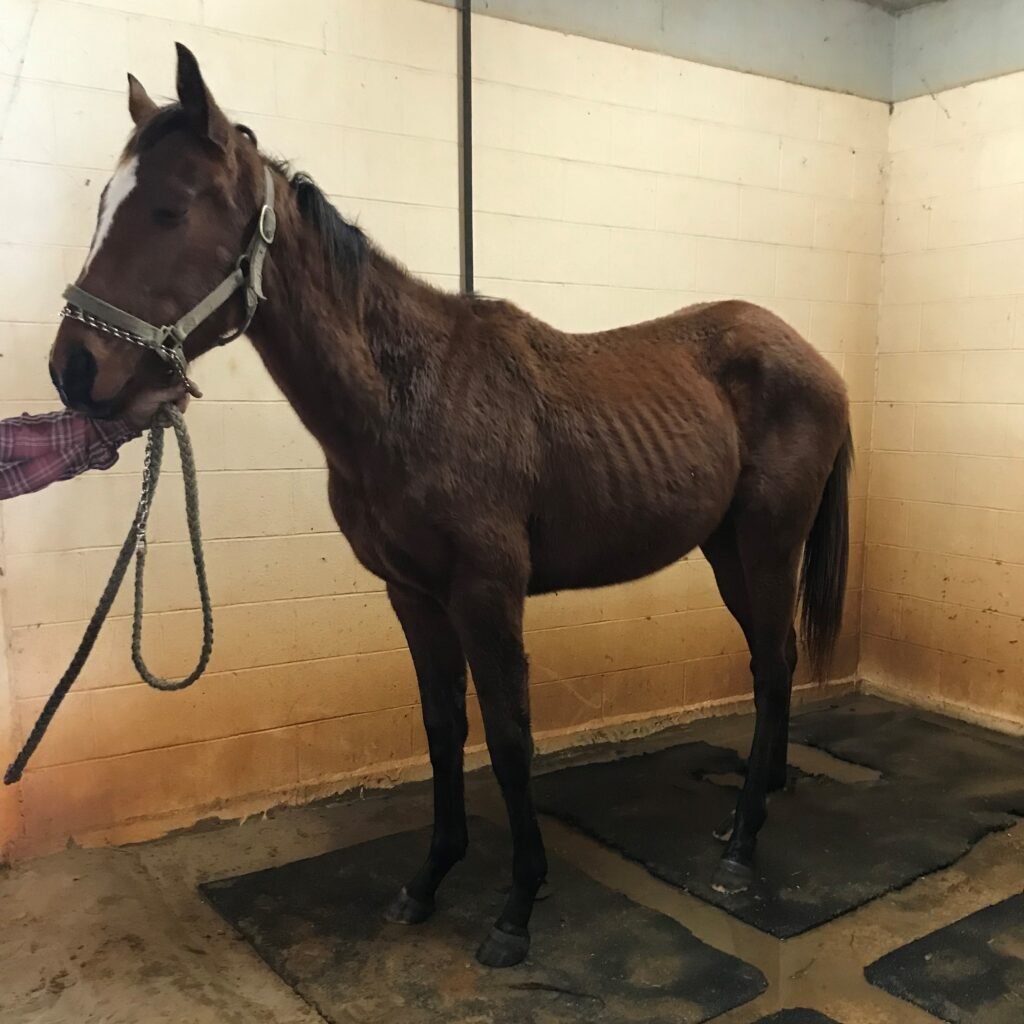
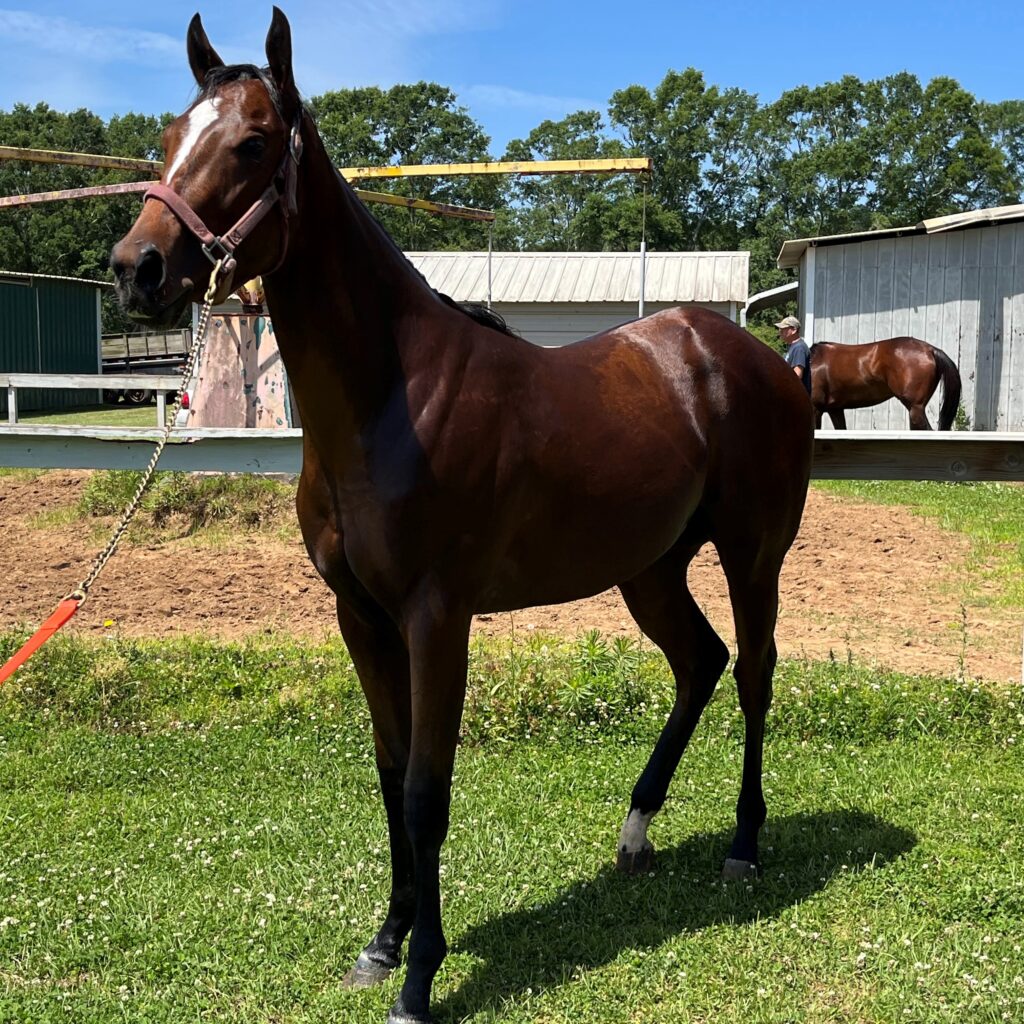
How to Put Weight on a Horse: Understanding the Basics
Gaining weight and muscle isn’t a one-size-fits-all process for horses. Just like people, horses have individual needs that must be carefully assessed. Let’s dive into understanding what your horse specifically requires.
Assessing Your Horse’s Weight and Condition
The first step in a successful weight gain strategy is to gauge your horse’s current condition accurately. Here’s how to do it:
- Visual Inspection: Look for visible ribs, sunken hips, or a tucked-up abdomen. These signs can indicate underweight conditions. For more detailed guidance, check out how to assess if your horse is too skinny.
- Body Condition Scoring (BCS): The Henneke Body Condition Scoring system systematically determines a horse’s fat and muscle condition. Scores range from 1 (emaciated) to 9 (obese), with an ideal range between 4 and 6.
- Weighing: If possible, weigh your horse using a livestock scale. Approximate measurements can also be made using a weight tape.
📝 Track Your Horse’s Progress! Don’t forget to download the free Henneke Body Condition Score Sheet here to monitor your horse’s weight gain journey.
Why Professional Insight Is Crucial for Weight Gain Plans
- Professional Opinion: An experienced vet or equine nutritionist can provide tailored recommendations. They’ll consider breed, age, activity level, and other unique factors. Learn why regular veterinary check-ups are essential for weight management.
- Diet Planning: A nutritionist can create a customized feeding plan that focuses on weight gain and muscle development, aligning with your horse’s needs. Explore feeding horses for health and wellness.
Identifying Health Conditions That Impact Weight
- Health Examination: It’s essential to rule out underlying health issues that might be causing weight loss. Problems like dental issues, parasites, or metabolic disorders can significantly impact a horse’s weight. Learn more about common causes of weight loss in horses.
- Lab Tests: Sometimes, a blood test or other diagnostic tools may be necessary to identify hidden health challenges. Your veterinarian can help diagnose and treat parasite-related weight loss.

Key Factors to Consider When Helping a Horse Gain Weight
Different breeds, ages, and individual horse needs require tailored approaches to weight gain. Understanding these factors ensures a targeted and effective plan:
Breed-Specific Considerations
- Each breed has a unique healthy weight range. For instance, Thoroughbreds are naturally leaner than bulkier breeds like Clydesdales or Draft Horses.
- Some breeds are more prone to being “hard keepers,” requiring higher-calorie diets to maintain their condition.
Age and Metabolic Rate
- Younger Horses: Naturally leaner due to growth and high activity levels but still need balanced nutrition to avoid developmental issues.
- Older Horses: Often struggle with slowed metabolism or dental problems that affect their ability to chew and digest food properly. Dental care, such as floating teeth, can address this issue. Learn more about maintaining horse dental health.
Individual Traits
- Recognizing whether your horse is an ‘easy keeper’ or ‘hard keeper’ can help tailor feeding and care strategies. Hard keepers may need more calorie-dense feeds and consistent exercise to improve muscle tone.
- Environmental factors, like climate and stress levels, also influence weight gain. Horses in colder environments require more energy to maintain body heat, while stress can suppress appetite. Learn about managing stress in horses.
Professional Insight
- Consulting with an equine nutritionist or veterinarian helps customize a plan based on your horse’s unique needs. Regular veterinary check-ups ensure you catch underlying issues like parasites or metabolic disorders.
By focusing on these factors, you lay the groundwork for a healthier, happier horse. Remember, understanding your horse’s unique needs is the first step toward success.

Seasonal Challenges in Winter Weight Gain
Winter increases your horse’s caloric needs as they expend more energy staying warm. To help maintain weight during colder months:
- Increase Forage Intake: Provide free-choice hay, as its fermentation generates heat and helps maintain body temperature.
- Add Calorie-Dense Feeds: Incorporate supplements like beet pulp or rice bran to boost energy levels.
- Encourage Hydration: Use heated water buckets or de-icers to keep water from freezing, and offer lukewarm water to promote drinking.
- Minimize Heat Loss: Ensure access to windproof shelters or barns, and use well-fitted blankets for thin or older horses.
By focusing on these essentials, you can keep your horse healthy and thriving during winter’s challenges.

How to Put Weight on a Horse Quickly and Safely
To achieve the goal of helping your horse gain weight and muscle, it’s crucial to consider a comprehensive nutritional approach that goes beyond calories.
Quick and Safe Ways to Put Weight on a Horse
For horses that need to gain weight swiftly, here’s how to do it thoughtfully:
- High-Calorie Feeds and Supplements: Oils, rice bran, or flaxseed are great sources of healthy fats that add calories without excess starch. Specialized weight gain supplements like Purina Amplify can also be beneficial. Explore our guide on choosing the right supplements.
- Hay Choices: Quality forages like alfalfa hay can be essential in adding calories. Ensure the hay is fresh, free of mold, and properly stored. Learn more about the best hay for horses to meet their nutritional needs.
- Balanced Diet Including Essential Vitamins and Minerals: Calcium, Phosphorus, and Vitamin E are crucial. Consulting with an equine nutritionist ensures a proper balance. Refer to AAEP guidelines on equine nutrition for expert advice.
Building Muscle While Adding Weight to a Horse
Building muscle is an art that requires precise nutritional attention:
- Protein Sources and Amino Acids: Protein is essential for muscle development. Include alfalfa or soybean meal for high-quality protein, focusing on amino acids like lysine. Learn how protein impacts horse nutrition.
- Hay and Fiber: Digestible fibers like beet pulp or high-quality grass hay are vital for healthy digestion and energy. Discover why fiber is essential for horse health.
- Feeding Schedule and Portion Control: Dividing meals into smaller portions helps digestion and nutrient absorption. Consistent feeding schedules also promote gut health.
- Understanding Starch and Sugar: While starch provides energy, excessive amounts (e.g., from corn) can cause digestive issues. Balance is critical. Read more about starch in equine diets.

Considerations for Different Needs
- Underweight Horses: Focus on energy-dense feeds with higher fat content. Alfalfa hay, with its higher calorie and protein levels, can be particularly helpful.
- Muscle Building in Athletic Horses: Protein and controlled starch levels are key. Exercise must complement the diet, as muscle development requires both proper nutrition and physical activity. Learn about conditioning your horse for optimal fitness.
Key Takeaways
Putting weight and muscle on a horse involves an intricate understanding of nutrition. It’s not just about feeding more but feeding the right kinds of food. High-quality hay, digestible fibers, protein sources, and a balance of essential vitamins and minerals all contribute to the process. Collaborating with a veterinarian or equine nutritionist ensures a precise diet tailored to your horse’s unique needs.
Patience and observation are crucial. Watch your horse’s progress and adjust as needed. Your dedication to these nutritional principles will help your horse gain weight and muscle in a healthy and sustainable way.
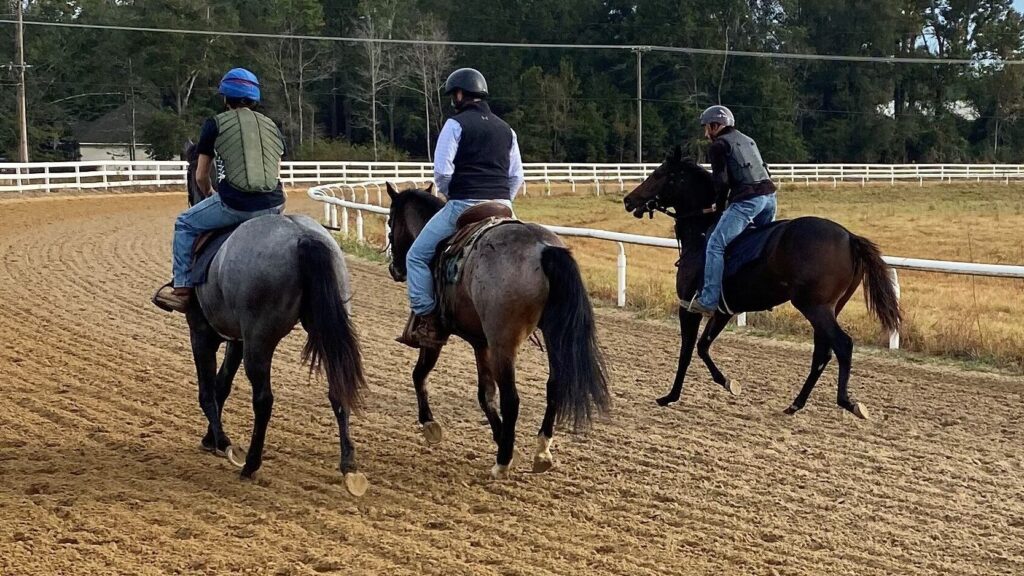
Practical Steps to Support Weight Gain and Muscle Development
Once you’ve assessed your horse’s needs, it’s time to implement an actionable plan. This section highlights the practical steps to help your horse gain weight and build muscle safely and effectively.
Nutritional Guidelines
- High-Quality Forage: The foundation of any horse’s diet. Offer free-choice alfalfa hay or high-quality grass hay to provide fiber and calories.
- Calorie-Dense Feeds:
- Add beet pulp or rice bran for energy without excess starch.
- Incorporate oils like flaxseed or corn oil for additional calories.
- Use specialized weight gain supplements like Purina Amplify for hard keepers.
- Balanced Nutrition: Ensure a diet rich in essential vitamins (e.g., Vitamin E), minerals (e.g., calcium and phosphorus), and amino acids (e.g., lysine). Refer to AAEP Care Guidelines for expert advice.
Exercise Regimen
- Low-Impact to High-Impact Training:
- Begin with walking and trotting before progressing to hill work or cantering.
- Focus on building muscle gradually to prevent strain.
- Resistance Training:
- Activities like pulling lightweight objects can enhance strength.
- Groundwork exercises improve balance and core stability.
- Learn more about conditioning young horses for health and soundness.

Monitoring Progress
- Regular Assessments:
- Track progress using the Body Condition Scoring System (BCS).
- Weigh your horse monthly or use a weight tape for consistent measurement.
- Signs of Success:
- A shiny coat, fuller body, and increased energy levels indicate positive changes. Read expert tips for achieving a shiny coat.
- Red Flags:
- Persistent weight loss, irritability, or lack of energy may signal underlying issues requiring veterinary attention.
Rest and Recovery
- Adequate rest between exercise sessions allows muscles to repair and grow. Ensure your horse gets sufficient downtime to avoid overexertion.
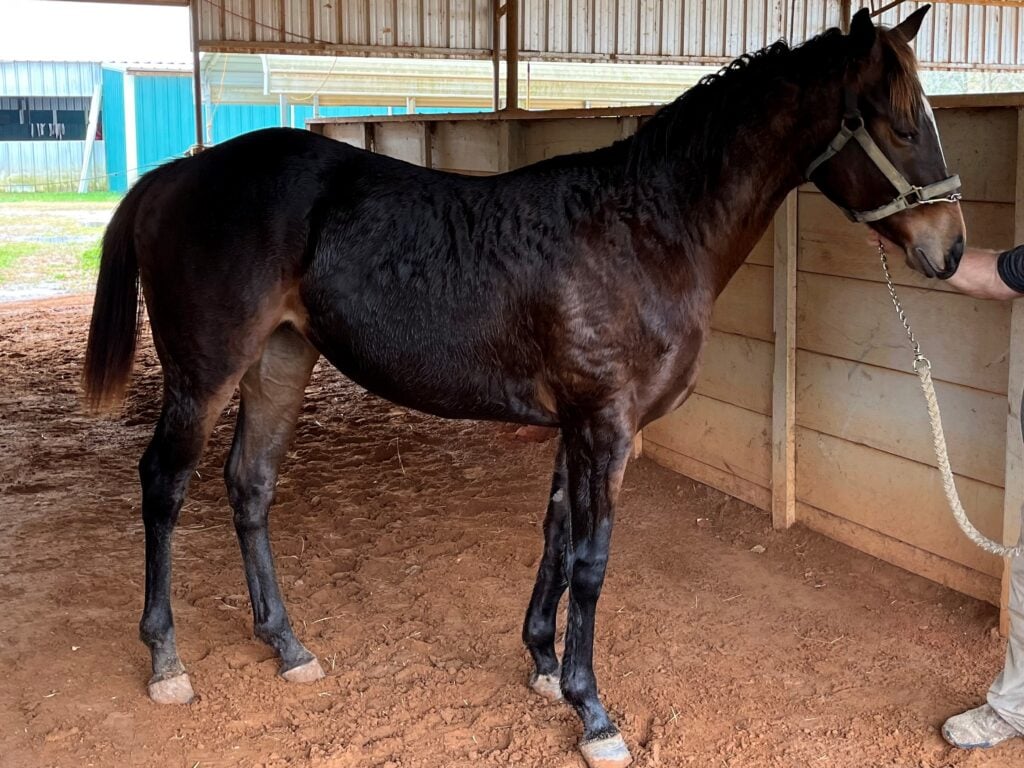

Case Study: How to Put Weight on a Horse with Jimmy’s Recovery
Jimmy, a two-year-old Thoroughbred colt, was severely underweight when purchased. A veterinary exam revealed he had worms. We addressed this with deworming and nutritional intervention. His diet included high-quality hay, fortified grains, and calorie-dense supplements like rice bran.
Controlled exercise built muscle without excess calorie burn. Within eight weeks, his condition dramatically improved, with a shiny coat and better muscle tone.
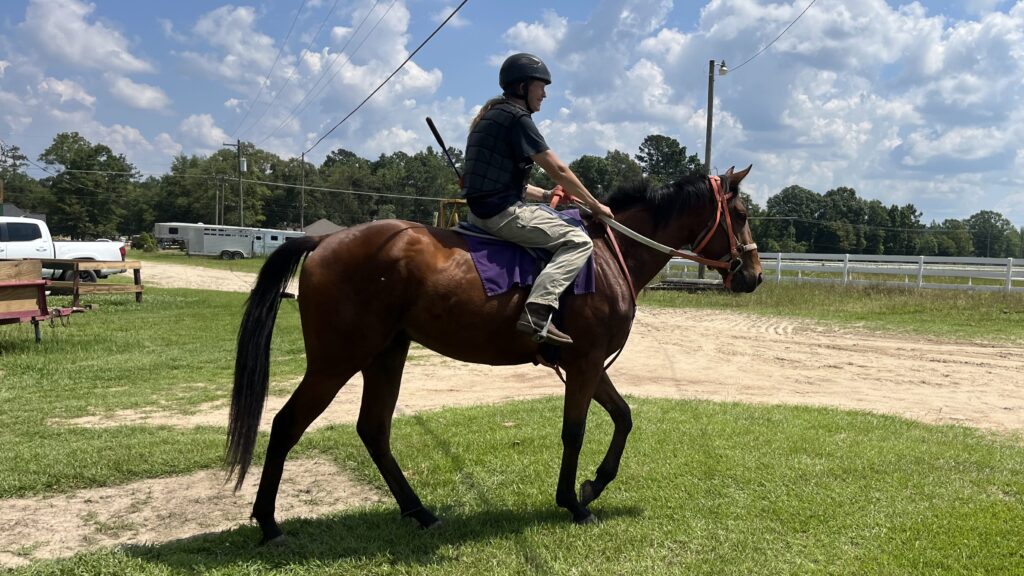
Best Practices and Common Mistakes in Weight Gain Programs
Helping a horse gain weight and muscle is a delicate process. Here are actionable tips to follow and pitfalls to avoid:
Avoiding Rapid Weight Gain That May Lead to Health Issues
- Best Practice: Gradual weight gain of around 50 pounds per month ensures a steady and safe recovery.
- Common Mistake: Overfeeding or rapidly increasing calorie intake can lead to colic or laminitis, both of which are serious health risks.
Ensuring Muscle Growth Without Overworking the Horse
- Best Practice: Develop a structured exercise routine with increasing intensity over time, incorporating rest days to allow for muscle recovery.
- Common Mistake: Over-exercising in an attempt to accelerate muscle gain can result in fatigue, stress, or injury.
Balancing the Needs of Individual Horses
- Best Practice: Tailor the program to your horse’s age, breed, and fitness level. Younger horses may need gentler routines, while athletic breeds might require more intensive muscle-building strategies.
- Common Mistake: A one-size-fits-all approach ignores the unique needs of your horse, which can hinder progress or cause harm.
Pro Tip: Collaborate with professionals, including veterinarians and nutritionists, to design a program that meets your horse’s specific needs. Explore equine nutrition best practices.
Below is a YouTube video that explains how to feed your horse to help it gain weight.
FAQs About How to Put Weight on a Horse
Do oats help horses gain weight?
Yes, oats are a good source of calories and can help horses gain weight when fed in appropriate amounts alongside other essential nutrients. For better nutrient absorption, horse owners should soak or steam oats before feeding them to their horses.
Are hard keepers incapable of gaining weight?
Hard keepers can gain weight with the right care and feeding strategy. These horses may require calorie-dense feeds, consistent exercise to build muscle, and tailored diet plans from an equine nutritionist.
What’s the best way to monitor my horse’s progress during a weight gain program?
Use the Body Condition Scoring System (BCS) and a weight tape or scale to track changes biweekly. Take photos regularly for visual comparisons and note improvements in coat condition, muscle tone, and energy levels. Regular check-ins with a vet or nutritionist can help refine the program as needed.
Can stress prevent weight gain in horses, and how can it be managed?
Yes, stress can hinder weight gain by affecting appetite and digestion. To manage it, ensure your horse has a consistent routine, access to turnout, and a calm environment. Consider calming supplements or consulting a veterinarian for persistent stress.
What signs indicate that my horse’s weight gain plan is working?
Key indicators include a fuller body, improved muscle tone, a shinier coat, and increased energy levels. Regularly monitor progress using body condition scoring and weight tape measurements.

Conclusion: Ensuring Long-Term Success in Weight Gain for Horses
Helping your horse gain weight and build muscle is a journey that requires patience, attention to detail, and a balanced approach. By focusing on proper nutrition, tailored exercise, and consistent monitoring, you can ensure your horse’s health and well-being improve sustainably.
Over the years, I’ve worked with many horses in need of weight gain, from off-the-track Thoroughbreds to rescues with unique challenges. I’ve seen firsthand how a thoughtful plan and consistent care can transform a horse’s condition. These experiences have shaped the advice in this guide, and I hope it helps you achieve similar success.
What You Can Do Next
Take the next step toward a healthier, happier horse:
- Share Your Story: What worked for you when helping an underweight horse? Share your story!
- Ask for Advice: Need advice? Post a question below, and let’s troubleshoot together.
- Spread the Word: If you know someone who could benefit from these tips, share this article with them.
- Stay Updated: Subscribe to our newsletter for expert horse care tips, nutrition advice, and more.
Your dedication and effort reflect the care you have for your horse. By applying these strategies, you’ll not only help them gain weight safely but also foster their happiness, health, and longevity. Remember, each step you take brings your horse closer to a healthier, more vibrant life.
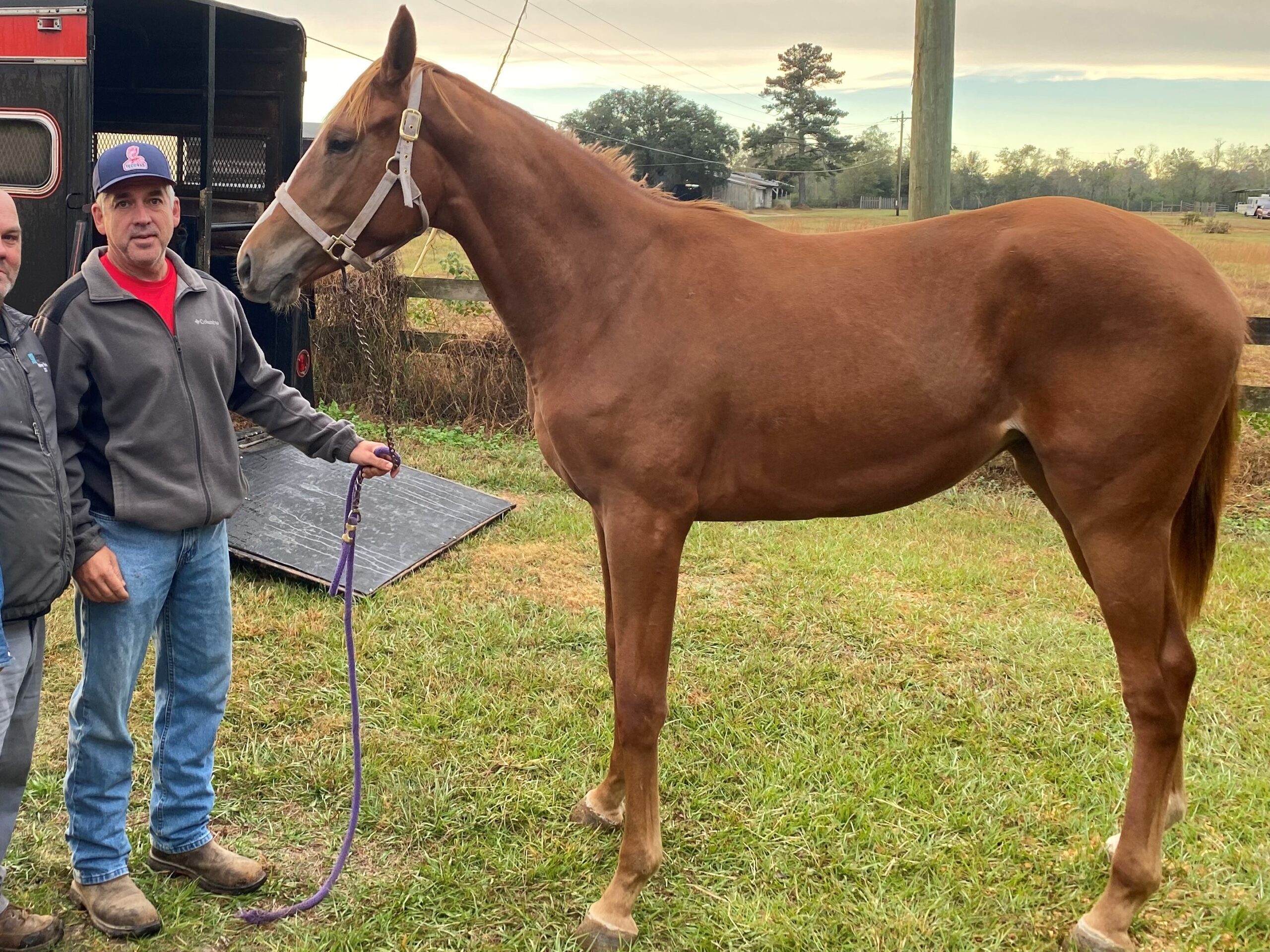
About the Author: Miles Henry
Lifelong Horseman | Racehorse Owner | Published Author
Miles Henry brings over 25 years of hands-on experience training and owning Thoroughbred racehorses. Raised with Quarter Horses and Appaloosas, he’s spent a lifetime learning from horses—on the track, in the barn, and in the field. Today, he runs a small but successful racing stable in Louisiana and shares real-world insights on HorseRacingSense.com, helping horse owners, fans, and bettors navigate the sport with confidence.
📚 Books: View Miles’s books on Amazon »
🎧 Podcast Guest: Animal Tales Ep. 32 |
YouTube Interview
📩 Newsletter: Sign up for racing tips and horse care advice »
🔗 Follow Miles:
Twitter |
Facebook |
YouTube


